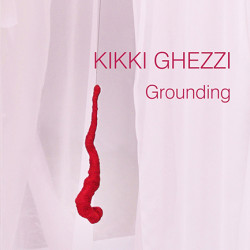September 2015 |
The Power of the Center
Sara Fontana
An artistic journey that seemed to have crystallized around painting is expanding into an exploration of other media. Painting, drawing, embroidery, installations, prints, papier collé collages, and artist’s books, traversed by writing and nourished by readings and heterogeneous visual sources, model a harmonious setting, hovering between the physical and the immaterial. It is a space in which Kikki Ghezzi hones her reflections on identity, strengthened by a new freedom and awareness. Pink is the predominant color, pink the experiences, images and objects that fill it, starting from a bewitching “femme-maison”. The series of prints is an accentuation of that continuous reticular line refined in the latest drawings with “portraits” of roots, to which is added a study of color perception. Dialoguing with previous research is the new series of oil paintings -from Celestial Roots to I am That I Am to Power of the Center I and II -where memory traces have now been transfigured, arranged along a crest between naturalism and mysticism, and where the gesture and the action unleash centripetal forces, without ever slackening control over the composition. The artist then turns to the motif of the case, of a Duchamp-like memory and model, and develops two installations from it brought to life by the intervention of the visitor. Here we discover that the root has not in fact been dissolved into the image on the canvas. Present and tangible, it is merely waiting to be revealed. Into this dialectic of internal/external, visible/invisible, dream/reality are slotted the artistic figures who, according to Ghezzi, inspired this work of hers more than any others: in addition to the already-mentioned Marcel Duchamp -an almost obligatory evocation -are Georgia O’Keeffe and Louise Bourgeois, masters, in different ways, of letting the organic and the abstract rub shoulders, and of superimposing the female body on the forms and forces of the Earth and Nature.
The enracinement of Kikki Ghezzi
Ilaria Riccioni
According to Simone Weil, l’enracinement is one of the deepest yearnings of the human soul, which the West systematically began to assault back in the early 1900s, undermining an invisible potential, universal community. For Weil, l’enracinement, or the act of putting down roots, not only has a personal implication linked to the survival of the individual, but indicates how a physical place can respond to needs for spiritual nourishment, an impalpable interweaving of relationships which, starting from a personal level, operates in the universal. In this sense, Kikki Ghezzi’s work seems to hark back to that same need, even if triggered by quite different motives. This exhibition presents the artist’s observation of the process of re-elaborating her roots, a personal journey that becomes universal. The root as symbol and object becomes the guiding thread of a creative journey through which the artist questions herself -and us -on our origins and the need to be reborn from ourselves to acquire citizenship in change: what is the right distance from our roots? The ambivalent oscillation between the past, as the “first root” that nourishes, and personal experience directed towards the new, becomes necessary to “transform fears into love” and manifest these in a pictorial act that plays on the emotional power of colors. This process is underpinned by relentless work on memory that prepares for cosmic and universal consonance, leaving artistic acts and objects in its wake. The objects show Kikki Ghezzi’s artistic style: a “home-valise”, as an alchemical container that transforms the pictorial work into an artistic act, with a nod to Duchamp, and a “root-valise” in which territory becomes space, with memory traces transformed into new stimuli. On the road from rooting to uprooting are two witnesses: a printed mirror that documents changes without fixing them, letting them go, and a book drawn with sentimental strokes. Out of the second case comes a pink installation oriented towards the sky; in the heart of the installation sways a red root, suspended, uprooted; it seems to wish to manifest what is not normally visible, while still remaining earth-bound. These may be invitations to reconsider the meaning of territory as space, of relationship as a changing action; the meaning of belonging enlarged as an idea of Franciscan brotherhood. Omnia mea mecum porto, Kikki Ghezzi seems to be telling us, transforming an oft-tormented theme into a creative gesture traversed by dialoguing colors, numeric correspondences, prints of different colors; her case-containers are functional and symbolic objects representing both material uprooting and enracinement in the heart, within themselves; while serving also as carrying cases between the personal and the universal. It symbolizes a personal path re-inventing origins that seems to intuitively embrace the uprooting of globalized society, the complex identities that move within it, and the growing lack of territoriality in means of communication, including historical and political questions that the Alto Adige region incarnates as a borderland.
